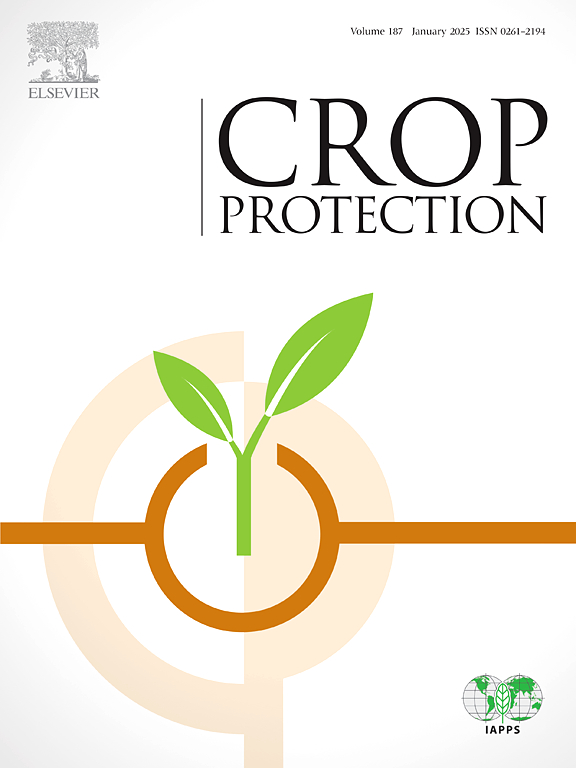Adaptive divergence in Ostrinia furnacalis: Diet-based fitness specification across wild, domestic and hybrid populations
IF 2.5
2区 农林科学
Q1 AGRONOMY
引用次数: 0
Abstract
The adaptability of agricultural pests to varied environments is a critical factor in their ability to cause significant damage, making it a major challenge for effective crop management. While the adaptability of Asian corn borer (Ostrinia furnacalis) (Lepidoptera: Crambidae) is well-documented, the extent to which different populations diverge in fitness when reared on natural versus artificial diets remains poorly understood. This study addresses this gap by assessing the fitness and adaptive divergence of three O. furnacalis populations i.e., field, laboratory, and hybrid (field × laboratory), when reared on maize and artificial diets, using age-stage, two-sex life table theory. Significant differences in survival and demographic parameters were observed among the populations. The field population exhibited 32.5 % faster growth on maize, with a shorter mean generation time (T) compared to the artificial diet. In contrast, the laboratory population grew (T) 29.5 % faster on the artificial diet compared to maize. The hybrid population showed a slight preference for maize, with growth (T) being 3.1 % faster than on the artificial diet. Trends in intrinsic rate of increase (r), finite rate of increase (λ) and other associated parameters followed a consistent pattern, with field population thriving on maize and laboratory population better suited to the artificial diet. The hybrid population demonstrated balanced adaptability to both diets, with an overall slight tendency of better performing on maize. This study highlights the importance of diet-specific adaptation in O. furnacalis and provides critical insights into the adaptive divergence for optimising laboratory rearing practices and improving pest management strategies.

亚洲玉米螟的适应性分化:野生、家养和杂交种群的基于饮食的适应度规范
农业害虫对不同环境的适应性是其造成重大损害能力的关键因素,使其成为有效作物管理的主要挑战。虽然亚洲玉米螟(Ostrinia furnacalis)(鳞翅目:蛾科)的适应性得到了充分的记录,但不同种群在自然饲养和人工饲养时的适应性差异程度仍然知之甚少。本研究利用年龄阶段、两性生命表理论,通过评估田间、实验室和杂交(田间×实验室)玉米螟种群在饲喂玉米和人工饲料时的适合度和适应差异,解决了这一差距。在人群中观察到生存率和人口统计学参数的显著差异。田间种群在玉米上的生长速度比人工饲料快32.5%,平均世代时间(T)比人工饲料短。相比之下,实验室种群在人工饲料上的生长速度比玉米快29.5%。杂交群体对玉米表现出轻微的偏好,其生长(T)比人工饲料快3.1%。内在增长率(r)、有限增长率(λ)和其他相关参数的趋势遵循一致的模式,田间种群以玉米为食,实验室种群更适合人工饲料。杂交群体对两种日粮表现出平衡的适应性,总体上对玉米表现出较好的趋势。本研究强调了黄颡鱼饮食特异性适应的重要性,并为优化实验室饲养实践和改进病虫害管理策略提供了重要的见解。
本文章由计算机程序翻译,如有差异,请以英文原文为准。
求助全文
约1分钟内获得全文
求助全文
来源期刊

Crop Protection
农林科学-农艺学
CiteScore
6.10
自引率
3.60%
发文量
200
审稿时长
29 days
期刊介绍:
The Editors of Crop Protection especially welcome papers describing an interdisciplinary approach showing how different control strategies can be integrated into practical pest management programs, covering high and low input agricultural systems worldwide. Crop Protection particularly emphasizes the practical aspects of control in the field and for protected crops, and includes work which may lead in the near future to more effective control. The journal does not duplicate the many existing excellent biological science journals, which deal mainly with the more fundamental aspects of plant pathology, applied zoology and weed science. Crop Protection covers all practical aspects of pest, disease and weed control, including the following topics:
-Abiotic damage-
Agronomic control methods-
Assessment of pest and disease damage-
Molecular methods for the detection and assessment of pests and diseases-
Biological control-
Biorational pesticides-
Control of animal pests of world crops-
Control of diseases of crop plants caused by microorganisms-
Control of weeds and integrated management-
Economic considerations-
Effects of plant growth regulators-
Environmental benefits of reduced pesticide use-
Environmental effects of pesticides-
Epidemiology of pests and diseases in relation to control-
GM Crops, and genetic engineering applications-
Importance and control of postharvest crop losses-
Integrated control-
Interrelationships and compatibility among different control strategies-
Invasive species as they relate to implications for crop protection-
Pesticide application methods-
Pest management-
Phytobiomes for pest and disease control-
Resistance management-
Sampling and monitoring schemes for diseases, nematodes, pests and weeds.
 求助内容:
求助内容: 应助结果提醒方式:
应助结果提醒方式:


